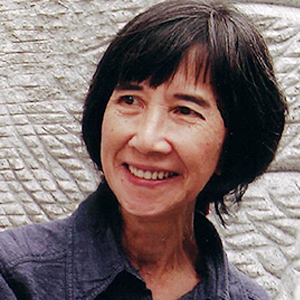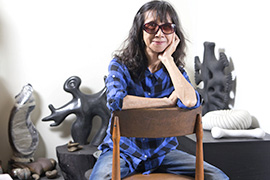
BORN
1943
INDUCTED
2014
CATEGORY
Arts & Culture

THE HONOURED INDUCTEES TO THE SINGAPORE WOMEN’S HALL OF FAME
Han Sai Por
Her slight frame and quiet manner belie a strong mind and unbounded imagination well served by steady hands. Han Sai Por is considered South-East Asia’s top sculptor. Her sizeable works in granite, marble and glass catch the eye at landmarks across Singapore. Witness her Seeds Series at Esplanade Park, the Seeds carved out of sandstone at Fort Canning Park and Shimmering Pearls outside Capital Tower.
Sai Por’s is a life of true grit. Born in 1943 during the Japanese Occupation, she grew up with her five siblings in a ramshackle hut in Changi. At the nearby Changi beach, as her mother scavenged to help support the family, Sai Por made animal figures out of the sand. When she was 10, her mother have a book that had pictures of Michelangelo’s sculptures. Sai Por knew then that she wanted to be an artist.
After secondary school, Sai Por attended the Teacher’s Training College from 1965 to 1968 and then worked as a teacher for 12 years. When she had saved enough money, she went to London to study art.
In 1983, she earned an Honours degree in Fine Art from Wolverhampton College of Art. Sai Por credits her teacher there, Anish Kapoor, with spotting her talent for three-dimensional art and directing her energies to sculpting and to try stone-carving. She loved it. “Working with stone was very touching somehow. It gave me an emotional feeling,” she said in an interview in 2014.
On her return to Singapore, she sculpted while teaching part-time to pay the bills. Solo exhibitions and works such as Goddess of Happiness, Pisces and Tropical Leaves established her credentials and enabled her to be a full-time artist in 1996. “I like to think my sculpture has a force or inner life inside struggling to get out,” she once said.
A prolific sculptor, she held seven solo exhibitions between 1993 and 2013, and participated in group exhibitions and international sculpture symposia. Noticeable works include Progressive Flow at NTUC headquarters and Flora Inspiration at Changi Airport Terminal 3. Some of her more than 20 public sculptures are on display as far afield as the Portland Sculpture Park in England, the US, Malaysia, Japan and China.
Sai Por won the Cultural Medallion in 1995, the top prize at the 11th Triennale India in 2005 and the Outstanding City Sculpture Award in China in 2006. She was a finalist at the Beijing Olympics International Tour Exhibition in 2008. In 2001, she was the founding president of the Sculpture Society (Singapore).
“She’s very gifted… she took on the hardest of material (granite), difficult to cut and turned them into beautiful sculptures which are so organic in form, they look as if they were growing out of the ground,” Joseph McNally, then principal of LaSalle-SIA College of the Arts, said in 1995.
As one who draws on nature for inspiration, Sai Por feels impelled to call attention to the pollution and degradation of the earth. “My concern about the environment is delivered through my art,” she said, referring to her solo exhibition Black Forest 2013.
The sculptor, who is single, now lives with her sister. At 70, Sai Por said she would keep on creating until her strength gave out. But she let her membership of MENSA lapse. Why? Because MENSA is “boring”. Sculpting is much more interesting.

Han Sai Por
BORN 1943 INDUCTED 2014
CATEGORY Arts & Culture
Her slight frame and quiet manner belie a strong mind and unbounded imagination well served by steady hands. Han Sai Por is considered South-East Asia’s top sculptor. Her sizeable works in granite, marble and glass catch the eye at landmarks across Singapore. Witness her Seeds Series at Esplanade Park, the Seeds carved out of sandstone at Fort Canning Park and Shimmering Pearls outside Capital Tower.
Sai Por’s is a life of true grit. Born in 1943 during the Japanese Occupation, she grew up with her five siblings in a ramshackle hut in Changi. At the nearby Changi beach, as her mother scavenged to help support the family, Sai Por made animal figures out of the sand. When she was 10, her mother have a book that had pictures of Michelangelo’s sculptures. Sai Por knew then that she wanted to be an artist.
After secondary school, Sai Por attended the Teacher’s Training College from 1965 to 1968 and then worked as a teacher for 12 years. When she had saved enough money, she went to London to study art.
In 1983, she earned an Honours degree in Fine Art from Wolverhampton College of Art. Sai Por credits her teacher there, Anish Kapoor, with spotting her talent for three-dimensional art and directing her energies to sculpting and to try stone-carving. She loved it. “Working with stone was very touching somehow. It gave me an emotional feeling,” she said in an interview in 2014.
On her return to Singapore, she sculpted while teaching part-time to pay the bills. Solo exhibitions and works such as Goddess of Happiness, Pisces and Tropical Leaves established her credentials and enabled her to be a full-time artist in 1996. “I like to think my sculpture has a force or inner life inside struggling to get out,” she once said.
A prolific sculptor, she held seven solo exhibitions between 1993 and 2013, and participated in group exhibitions and international sculpture symposia. Noticeable works include Progressive Flow at NTUC headquarters and Flora Inspiration at Changi Airport Terminal 3. Some of her more than 20 public sculptures are on display as far afield as the Portland Sculpture Park in England, the US, Malaysia, Japan and China.
Sai Por won the Cultural Medallion in 1995, the top prize at the 11th Triennale India in 2005 and the Outstanding City Sculpture Award in China in 2006. She was a finalist at the Beijing Olympics International Tour Exhibition in 2008. In 2001, she was the founding president of the Sculpture Society (Singapore).
“She’s very gifted… she took on the hardest of material (granite), difficult to cut and turned them into beautiful sculptures which are so organic in form, they look as if they were growing out of the ground,” Joseph McNally, then principal of LaSalle-SIA College of the Arts, said in 1995.
As one who draws on nature for inspiration, Sai Por feels impelled to call attention to the pollution and degradation of the earth. “My concern about the environment is delivered through my art,” she said, referring to her solo exhibition Black Forest 2013.
The sculptor, who is single, now lives with her sister. At 70, Sai Por said she would keep on creating until her strength gave out. But she let her membership of MENSA lapse. Why? Because MENSA is “boring”. Sculpting is much more interesting.
“Art should come from the mind and the soul of the artist.” “Sculpture is an essential form of public art. Many modern cities understand that public art can elevate their living environment… Unfortunately, many art pieces at our public space are imitation artworks… This attitude will produce a lot of art junk occupying our public space, wasting public funds and discouraging local artistic development in future.”
“My parents couldn’t always take care of us so we had to be quite independent. We didn’t have toys so we played with leaves, gravel and seashells. I was brought up with nature, so my thinking was always focused on that. I worked with organic shape and got ideas from certain parts of plants — a leaf, seeds or pods.”
Sources:
- Han Sai Por shares about her passion for sculpting – Jan 17, 2014
- Interview with Han Sai Por – Mar 21, 2014
- National Library’s Singapore Infopedia
- All you want to know about the sculptor and her works on Han Sai Por’s website
- Biography in Wikipedia
- Message from Han Sai Por on Sculpture Society (Singapore) website
Gallery photo(s):
Courtesy of Esplanade – Theatres on the Bay
Profile last updated: 25th February 2022

